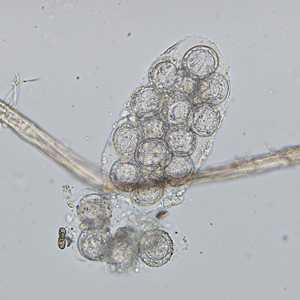
Case #336 - November, 2012
The DPDx Team received a worm-like object collected from a child's diaper for diagnostic assistance. Grossly, the object was white, semi-flattened, and measured approximately 4.0 mm long by 2.0 mm wide. With no discernible external features, the object was teased open and its internal contents examined microscopically. Figures A and B show what was observed from the tease preparation of the object. Individual round objects measured on average 37.0 µm in diameter. What is your diagnosis? Based on what criteria?

Figure A

Figure B
Case Answer
This was a case of dipylidiasis caused by the dog tapeworm, Dipylidium caninum. Diagnostic morphologic features included:
- eggs within the size range for D. caninum (35.0-40.0 µm in diameter).
- eggs containing refractile hooklets.
- eggs arranged in packets (best seen in Figure B).
More on: Dipylidium caninum
Images presented in the monthly case studies are from specimens submitted for diagnosis or archiving. On rare occasions, clinical histories given may be partly fictitious.
DPDx is an education resource designed for health professionals and laboratory scientists. For an overview including prevention and control visit www.cdc.gov/parasites/.
- Page last reviewed: August 24, 2016
- Page last updated: August 24, 2016
- Content source:
- Global Health – Division of Parasitic Diseases and Malaria
- Notice: Linking to a non-federal site does not constitute an endorsement by HHS, CDC or any of its employees of the sponsors or the information and products presented on the site.
- Maintained By:


 ShareCompartir
ShareCompartir